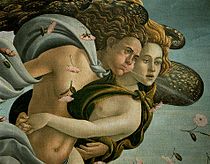The Birth of Venus (Botticelli)
 |
|
|
|
The Birth of Venus (Italian: Nascita di Venere [ˈnaʃʃita di ˈvɛːnere]) is a painting by Sandro Botticelli generally thought to have been made in the mid 1480s. It has long been suggested that Botticelli was commissioned to paint the work by the Medici family of Florence, Italy, specifically by Lorenzo di Pierfrancesco de' Medici (1463-1503) under the influence of his cousin Lorenzo de' Medici, a major patron of Botticelli. However, no originating documents associated with the painting survive, and its first linkage with the Medici family is not recorded until several decades after the supposed date of its creation, namely in the 1550 edition of Vasari's Lives. It depicts the goddess Venus, having emerged from the sea as an adult woman, arriving at the shore (which is related to the Venus Anadyomene motif). The painting is in the collection of the Uffizi Gallery in Florence.
The iconography of The Birth of Venus is similar to a description of the event (or rather, a description of a sculpture of the event) in a poem by Angelo Poliziano, the Stanze per la giostra. No single text provides the precise imagery of the painting, however, which has led scholars to propose many sources and interpretations. Art historians who specialize in the Italian Renaissance have found a Neoplatonic interpretation, which was most clearly articulated by Ernst Gombrich, to be the most enduring way to understand the painting. Botticelli represented the Neoplatonic idea of divine love in the form of a nude Venus.
...
Wikipedia
